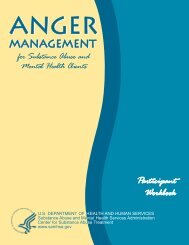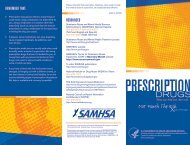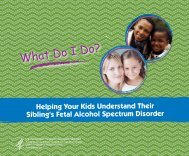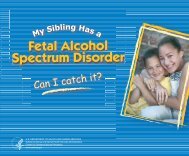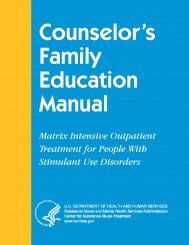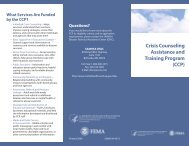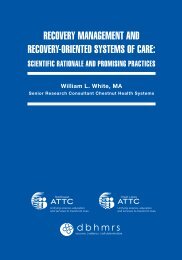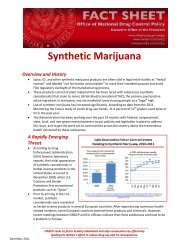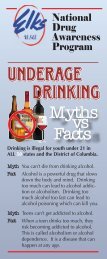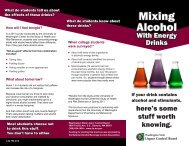Counselor's Manual for Relapse Prevention With Chemically ...
Counselor's Manual for Relapse Prevention With Chemically ...
Counselor's Manual for Relapse Prevention With Chemically ...
You also want an ePaper? Increase the reach of your titles
YUMPU automatically turns print PDFs into web optimized ePapers that Google loves.
Stopping self-defeating behaviors that prevent awareness of painful feelings and irrationalthoughtsLearning how to manage feelings and emotions responsibly without resorting to compulsivebehavior or the use of alcohol or drugsLearning to change addictive thinking patterns that create painful feelings and self-defeatingbehaviorsIdentifying and changing the mistaken core beliefs about oneself, others, and the world thatpromote irrational thinking.When people who have had a stable recovery and have done well begin to relapse, they simplyreverse this process. In other words, theyHave a mistaken belief that causes irrational thoughtsBegin to return to addictive thinking patterns that cause painful feelingsEngage in compulsive, self-defeating behaviors as a way to avoid the feelingsSeek out situations involving people who use alcohol and drugsFind themselves in more pain, thinking less rationally, and behaving less responsiblyFind themselves in a situation in which drug or alcohol use seems like a logical escape from theirpain, and they use alcohol or drugs.A number of basic principles and procedures underlie the CENAPS Model of <strong>Relapse</strong> <strong>Prevention</strong>Therapy. Each principle <strong>for</strong>ms the basis of specific relapse prevention therapy procedures.Counselors can use the following principles and procedures to develop appropriate treatmentplans <strong>for</strong> relapse-prone patients. Following a description of each principle is the relapseprevention procedure <strong>for</strong> that principle.Principle 1: Self-RegulationThe risk of relapse will decrease as a patient's capacity to self-regulate thinking, feeling,memory, judgment, and behavior increases.<strong>Relapse</strong> <strong>Prevention</strong> Procedure 1: StabilizationAn initial treatment plan is established that allows relapse-prone individuals to stabilizephysically, psychologically, and socially. The level of stabilization is measured by the ability toper<strong>for</strong>m the basic activities of daily living. Because the symptoms of withdrawal are stresssensitive,it is important to evaluate the patient's level of stability under both high and low stress.Many people who appear stable in a low-stress environment become unstable when placed in amore stressful environment.The stabilization process often includesDetoxification from alcohol and other drugsSolving the immediate crises that threaten sobrietyLearning skills to identify and manage Post Acute <strong>With</strong>drawal and Addictive Preoccupation



